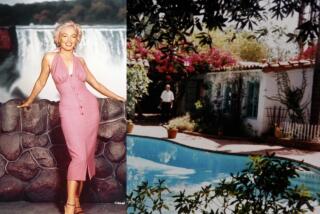Police Outline 2nd Sepulveda Barricade Zone to Stop Drugs
- Share via
Los Angeles police officials and community leaders Thursday mapped out a plan to temporarily barricade a second Sepulveda neighborhood beset by drive-by drug buyers.
The plan, which comes after police barricaded the nearby 12-square-block Columbus Avenue neighborhood last month to curtail narcotics traffic there, raises fresh questions about the effectiveness of cordoning off areas to fight drug activity.
Under the proposal, which would have to be approved by the City Council, a two-block section of Orion Avenue would be closed at Nordhoff and Parthenia streets by sawhorses that would be removed twice a day to allow 40 school buses from the local public school into the area.
Although there is no organized opposition, critics have said the technique will simply push the narcotics trade into neighboring areas, forcing officials to set up an ever-escalating number of roadblocks.
“If we start turning our cities into citadels by cutting off access to some streets, we will have diminished the basic rights of Americans in the name of fighting narcotics,” said Abraham Abramovsky, a law professor at Fordham University in New York. “With the Berlin Wall going down in Europe, it seems rather ironic that walls are being erected around parts of Los Angeles.”
Police officials last month conceded that drug traffic had increased in the Orion Avenue neighborhood as a result of barricades thrown up around the 12-square-block Columbus Avenue area, which is just four blocks west. But they said Orion Avenue already had an active drug trade and that closing it would not drive customers into single-family neighborhoods to the north and east because they would be too conspicuous there.
“The buyers don’t know where to go now, and our interest is to keep them off balance,” said Capt. Mark D. Stevens, adding that police will continue to seize cars owned by drug buyers during undercover sweeps. Using federal forfeiture laws, police earlier this month seized 18 cars from cocaine buyers visiting a Canoga Park neighborhood and the Orion Avenue area.
Stevens said police will hold a public meeting in January to gauge residents’ feelings about the proposed street closure. Thursday, he and other police officials met privately at the United Methodist Church in Sepulveda to discuss it with city transportation officials, firefighters and local school and church leaders.
Councilman Joel Wachs, who sent a representative to the meeting, said afterward that he will ask the City Council to approve the barricades on Orion Avenue early next year. Last month, the City Council approved the Columbus Avenue barricades at Wachs’ request.
Under the plan, residents of Orion Avenue would still be able to enter the neighborhood from Rayen Street. The barricades would be removed for 2 1/2-hour periods in the morning and afternoon to allow the 40 buses that pick up and drop off children at Langdon Avenue elementary school to continue using Orion Avenue, said Principal Dan Balderrama.
Richard Kunz, a spokesman for Wachs, said drug buyers could conceivably enter Orion Avenue during periods when it is open to school buses, but they probably would not want to operate part time.
Church and school officials at Thursday’s meeting said they support the barricades, regardless of their impact elsewhere.
More to Read
Sign up for Essential California
The most important California stories and recommendations in your inbox every morning.
You may occasionally receive promotional content from the Los Angeles Times.













